This article needs additional citations for verification .(February 2024) |
| |||||
| Decades: | |||||
|---|---|---|---|---|---|
| See also: | |||||
The following lists events that happened during 1990 in Somalia .
This article needs additional citations for verification .(February 2024) |
| |||||
| Decades: | |||||
|---|---|---|---|---|---|
| See also: | |||||
The following lists events that happened during 1990 in Somalia .
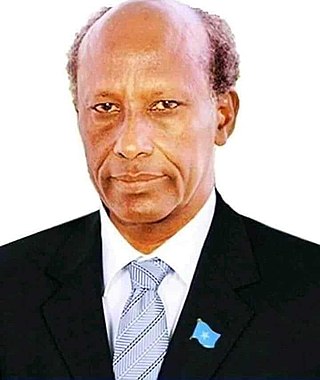
Mohamed Farrah Hasan Garad, popularly known as General Aidid or Aideed, was a Somali military officer and warlord.

Mohammed Siad Barre was a Somali military officer, politician and revolutionary who served as the third president of Somalia from 21 October 1969 to 26 January 1991.

Abdiqasim Salad Hassan, also known as Abdiqasim Salad, is a Somali politician who served as the fifth President of Somalia from 2000 to 2004. He helped found the Transitional National Government and previously served as Minister of Interior in the government of Siad Barre.
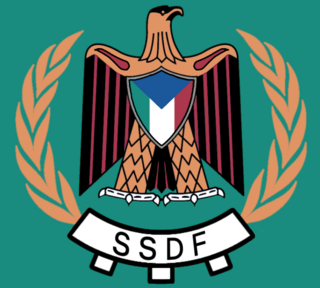
Somali Salvation Democratic Front (SSDF) (Somali: Jabhadda Diimuqraadiga Badbaadinta Soomaaliyeed), initially known as the Democratic Front for Salvation of Somalia, was a political and paramilitary umbrella organization in Somalia. Founded in 1978 by several army officers, it was the first of several opposition groups dedicated to ousting the authoritarian regime of Mohamed Siad Barre. With its power base mainly in the Majeerteen clan, SSDF played a significant role in the country's complex political landscape during the late 1970s and 2000s. And Succeeded by the establishment in 1998 of the autonomous Puntland state in northeastern Somalia.
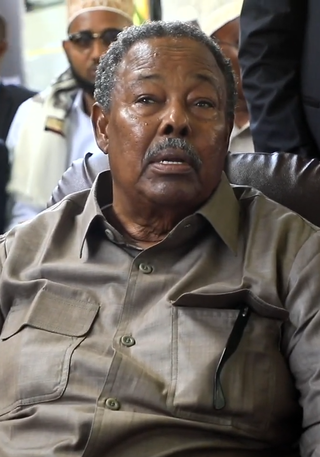
Ali Mahdi Muhammad was a Somali entrepreneur and politician. He served as President of Somalia from 26 January 1991 to 27 August 1993. The Cairo Agreement in December 1997 designated Ali Mahdi as president once again, a position he held until being succeeded by Abdiqasim Salad in the year 2000.

The United Somali Congress (USC) was one of the major rebel organizations in Somalia. Formed in 1989, it played a leading role in the ouster of the government of Siad Barre in 1991, and became a target of the Unified Task Force campaign in 1993. Following infighting, the USC later splintered into smaller groups. By 2000, with the establishment of a Transitional National Government (TNG), a process of disarmament was put in motion and some moderate ex-USC leaders were incorporated into the new interim administration.
Following the civil war and the ensuing societal chaos, some factions managed to exert a degree of authority over certain regions of Somalia where they maintained broad, clan-based support. This allowed these factions to establish working administrations and eventually coherent states, and restored order to their regions. This occurred first in Puntland, Southwestern Somalia, Galmudug, Jubaland and finally Banadir.
The Somali Rebellion was the start of the Somali Civil War that began in the 1970s and resulted in the collapse of the Somali Democratic Republic in 1991. The rebellion effectively began in 1978 following a failed coup d’état and President Siad Barre began using his special forces, the "Red Berets", to attack clan-based dissident groups opposed to his regime. Backed by Ethiopia, the two earliest rebel factions, the Somali Salvation Democratic Front (SSDF) and the Somali National Movement (SNM) began attacks during the against government forces during the early 1980s.
The Somali National Front (SNF) was a politico-military organization that operated in southern Somalia during the Somali Civil War and represented one of the major factions involved in the conflict.
Over the course of the Somali Civil War, there have been many revolutionary movements and militia groups run by competing rebel leaders which have held de facto control over vast areas within Somalia.
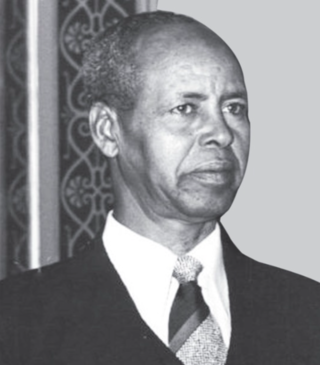
Hussein Kulmiye Afrah was the Vice President of Somalia during the era of Siad Barre, serving from 1972 to 1990. He was also a member of the Supreme Revolutionary Council and served as the Minister of Interior from 1971 to 1974.

Umar Arteh Ghalib or Omer Carte Qalib was a Somali politician. He was Prime Minister of the Somali Democratic Republic from January 24, 1991 to May 1993. Previously he served as Foreign Minister from 1969 to 1976.

The Supreme Revolutionary Council was the governmental body that ruled Somalia from 1969 to 1976.
The following lists events that happened during 1991 in Somalia.
The following lists events that happened during 1969 in Somalia.
The following lists events that happened during 1986 in the Somali Democratic Republic.
The following lists events that happened during 1970 in Somalia.

The Mayor of Mogadishu is head of the executive branch of Mogadishu, the capital of Somalia. The mayor's office administers all city services, public property, police and fire protection, most public agencies, and enforces laws within the city. Mayor Sheik Yousuf Hussein Jim'ale was appointed on 14 September 2022 and succeeded the Mayor Omar Mohamoud Mohamed Filish.

The 1969 Somali coup d'état was a bloodless military takeover of the Somali Republic on 21 October 1969, led by Somali National Army officers of the Supreme Revolutionary Council under General Siad Barre. After the assassination of President Abdirashid Shermarke in Las Anod, the Somali National Army under Barre's command stormed Mogadishu, seized key government buildings, and demanded the resignation of the country's leaders. The coup deposed acting President Sheikh Mukhtar Hussein and Prime Minister Mohammad Egal, ushering in a 21-year military rule under Barre and the establishment of an authoritarian government that lasted until 1991.
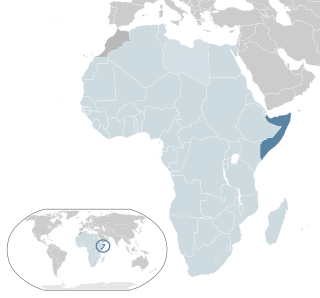
The 1978 Somali coup d'état attempt was a violent military coup attempt that took place in Somalia on 9 April 1978, against the regime of President Siad Barre. The United States Central Intelligence Agency estimated that the coup, led by Colonel Mohamed Osman Irro, involved around 24 officers, 2,000 soldiers, and 65 tanks. Following the failed coup, 17 alleged ringleaders, including Osman, were summarily executed by firing squad.